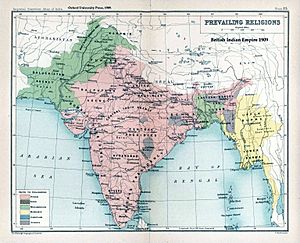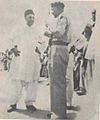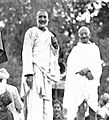Two-nation theory facts for kids

The two-nation theory (Urdu: دو قومی نظریہ do qaumī nazariya) is a very important idea behind the creation of Pakistan. In simple words, it means that Hindus and Muslims in the Indian subcontinent were seen as two separate "nations" or groups of people. They had many differences in their culture, religion, politics, economy, and social lives.
These differences led to two very different ideas about how the region should be governed. These ideas eventually caused the subcontinent to be divided into two independent countries: India and Pakistan. The two-nation theory was a main reason for the Pakistan Movement, which aimed to create Pakistan as a Muslim country in South Asia. It also led to the Partition of India in 1947.
Muhammad Ali Jinnah, a key leader, believed that religion was the most important thing that defined who Indian Muslims and Hindus were. He said this idea helped Muslims realize they needed their own country, Pakistan. Because of this, some Hindu groups also started to work towards making India a country mainly for Hindus.
Contents
What the Theory Means
There are different ways people understood the two-nation theory. Some thought that Hindus and Muslims could live together in one area, but Muslim-majority areas should have their own power, even the right to become separate countries. This idea did not involve moving people around.
Two Nations, Separate Homes
Another way of looking at the theory was that Hindus and Muslims had "two distinct and often opposing ways of life." This view suggested they could not live together peacefully in one country. In this version, it was thought that Hindus should move out of Muslim-majority areas, and Muslims should move out of Hindu-majority areas. This was seen as a way to fully separate two groups that were believed to be unable to live together in peace.
Who Disagreed with the Theory
Not everyone agreed with the two-nation theory. There were two main groups who opposed it.
One Indian Nation
One group believed that all people in India, including Hindus and Muslims, were part of a single Indian nation. They thought that Hindus and Muslims were connected communities. Even after Pakistan was formed, people in India continued to discuss whether Muslims and Hindus were truly separate nations or not.
Many Small Nations
The second group who disagreed thought that Indians were not one nation. However, they also believed that Muslims or Hindus were not single nations either. Instead, they felt that smaller, more similar regions within the subcontinent were the real "nations." They thought these smaller regions should have their own independence. For example, they might see the people of Bengal or Punjab as distinct nations, rather than all Muslims or all Hindus across the entire subcontinent.
Images for kids
-
Indian National Congress leaders Khan Abdul Ghaffar Khan and Mohandas Gandhi both supported Hindu–Muslim unity and were against the division of colonial India.
See also
 In Spanish: Teoría de las dos naciones para niños
In Spanish: Teoría de las dos naciones para niños





